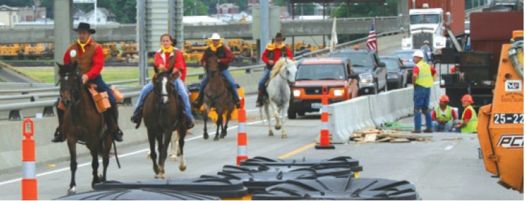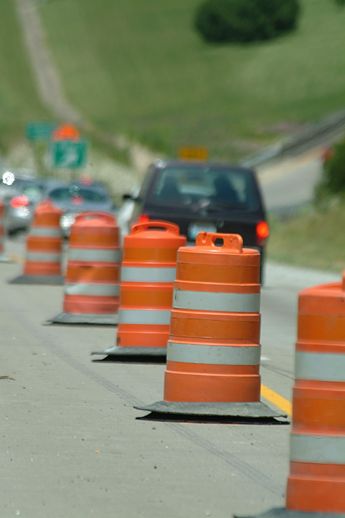Difference between revisions of "Category:616 Temporary Traffic Control"
m (Per Traffic, relabeled "other channelizing devices" figure) |
m |
||
| (11 intermediate revisions by the same user not shown) | |||
| Line 1: | Line 1: | ||
| − | [[image:616 TEMPORARY TRAFFIC CONTROL.jpg|left| | + | [[image:616 TEMPORARY TRAFFIC CONTROL.jpg|left|345px]] |
| Line 5: | Line 5: | ||
[[image:616 Law Enforcement.jpg|right|225px|thumb|<center>'''[[616.16 Law Enforcement Services|Law Enforcement]]'''</center>]] | [[image:616 Law Enforcement.jpg|right|225px|thumb|<center>'''[[616.16 Law Enforcement Services|Law Enforcement]]'''</center>]] | ||
| − | The | + | The workspace is the area closed to traffic and set aside for workers, equipment and material. Work zone signing items such as regulatory signs and Type III Movable Barricades and other work zone items such as Changeable Message Signs, flashing arrow panels, channelizing devices, lighting devices and signals are specially designed to minimize risk to workers and travelers. [[616.17 Pavement Edge Treatment|Pavement edge treatment]] is frequently included in work zones as are practices such as crossovers, temporary connections and detours. |
| − | |||
| − | |||
{|style="padding: 0.3em; margin-left:5px; border:1px solid #a9a9a9; text-align:center; font-size: 95%; background:#ffddcc" width="210px" align="right" | {|style="padding: 0.3em; margin-left:5px; border:1px solid #a9a9a9; text-align:center; font-size: 95%; background:#ffddcc" width="210px" align="right" | ||
|- | |- | ||
| Line 14: | Line 12: | ||
|[http://library.modot.mo.gov/RDT/reports/Ri07062/or10006.pdf Report, 2010] | |[http://library.modot.mo.gov/RDT/reports/Ri07062/or10006.pdf Report, 2010] | ||
|- | |- | ||
| − | |'''See also:''' [ | + | |'''See also:''' [https://www.modot.org/research-publications Research Publications] |
|} | |} | ||
| + | |||
| + | The work zone duration and location of work are discussed in this article. There are many aspects to be considered when inspecting construction quality and this article provides [[616.18 Construction Inspection Guidelines for Sec 616|construction inspection guidelines]]. | ||
Temporary traffic control devices warn motorists of hazards, advise the proper path through the work area, delineate areas where travelers may not operate and separate them from workers and opposing traffic. Whenever worn or damaged devices appear in a work zone, the general quality of the work zone deteriorates. To avoid this, MoDOT has provided [[616.19 Quality Standards for Temporary Traffic Control Devices|quality standards for temporary traffic control devices]]. | Temporary traffic control devices warn motorists of hazards, advise the proper path through the work area, delineate areas where travelers may not operate and separate them from workers and opposing traffic. Whenever worn or damaged devices appear in a work zone, the general quality of the work zone deteriorates. To avoid this, MoDOT has provided [[616.19 Quality Standards for Temporary Traffic Control Devices|quality standards for temporary traffic control devices]]. | ||
To provide uniform flagging and to train employees how to protect themselves, co-workers and travelers, MoDOT requires [[616.20 Flagger Training|flagger training]]. | To provide uniform flagging and to train employees how to protect themselves, co-workers and travelers, MoDOT requires [[616.20 Flagger Training|flagger training]]. | ||
| − | + | {|style="padding: 0.3em; margin-left:15px; border:2px solid #ff9933; text-align:left; font-size: 95%; background:#f5f5f5" width="650px" align="right" | |
| − | |||
| − | {|style="padding: 0.3em; margin-left:15px; border:2px solid #ff9933; text-align:left; font-size: 95%; background:#f5f5f5" width=" | ||
|- | |- | ||
|<center>[http://www.modot.mo.gov/workzones/Comments.htm '''Work Zone Customer Survey''']</center> | |<center>[http://www.modot.mo.gov/workzones/Comments.htm '''Work Zone Customer Survey''']</center> | ||
| Line 28: | Line 26: | ||
|Traffic has developed the [http://www.modot.mo.gov/workzones/Comments.htm Work Zone Customer Survey] to take advantage of travelers viewing MoDOT work zones. The Work Zone Customer Survey has been revised so that reviewing work zones is even easier. You can keep our work zones safe and efficient by submitting your information directly from the survey's website location or by printing, filling out and mailing the report card. | |Traffic has developed the [http://www.modot.mo.gov/workzones/Comments.htm Work Zone Customer Survey] to take advantage of travelers viewing MoDOT work zones. The Work Zone Customer Survey has been revised so that reviewing work zones is even easier. You can keep our work zones safe and efficient by submitting your information directly from the survey's website location or by printing, filling out and mailing the report card. | ||
|} | |} | ||
| + | Every day MoDOT has many [http://www.modot.mo.gov/workzones/index.htm work zones] on Missouri's highways. MoDOT is committed to providing safe and efficient movement of both motorized and non-motorized traffic through or around temporary traffic control work zones and providing protection for workers and equipment located within these work zones. To better educate technicians and those designing and managing temporary traffic control work zones, [[616.21 Work Zone Technician Training|Work Zone Technician Training]], [[616.22 Advanced Work Zone Training|Advanced Work Zone Training]], [[616.25.MoDOT Work Zone Guidelines|MoDOT Work Zone Guidelines]] and [[616.26 Work Zone User Training|Work Zone User Training]] is available. | ||
| + | |||
| + | [[image:616 non-motorized.jpg|right|525px|thumb|<center>'''Road workers look up to see [[616.24 Traffic Control for Non-Motorized Traffic|non-motorized traffic]]'''</center>]] | ||
This article also provides [[616.16 Law Enforcement Services|law enforcement services]], [[616.24 Traffic Control for Non-Motorized Traffic|traffic control for non-motorized traffic]] and [[616.15 Transit Considerations|transit considerations]]. | This article also provides [[616.16 Law Enforcement Services|law enforcement services]], [[616.24 Traffic Control for Non-Motorized Traffic|traffic control for non-motorized traffic]] and [[616.15 Transit Considerations|transit considerations]]. | ||
[[616.23 Traffic Control for Field Operations|Traffic Control for Field Operations]], contains information on temporary traffic control measures. | [[616.23 Traffic Control for Field Operations|Traffic Control for Field Operations]], contains information on temporary traffic control measures. | ||
| + | |||
| + | [[616.27 Fleet Lighting|Fleet lighting]] guidelines are also available. | ||
| + | {|style="padding: 0.3em; margin-left:40px; border:2px solid #a9a9a9; text-align:center; font-size: 95%; background:#f5f5f5" width="395px" align="left" | ||
| + | |- | ||
| + | |EPG articles are not referenced as "sections" but as EPG XXX.X or as "articles" to avoid confusion with MoDOT specs (which are contractually binding). | ||
| + | |} | ||
| + | |||
| + | |||
| + | |||
| + | |||
| + | |||
<div id="Work Zone Figures"></div> | <div id="Work Zone Figures"></div> | ||
| − | {|style="padding: 0.3em; margin-left:15px; border: | + | {|style="padding: 0.3em; margin-left:15px; border:6px solid #ff9933; text-align:center; font-size: 95%; background:#f5f5f5" width="700px" align="center" |
| − | |||
| − | |||
| − | |||
| − | |||
| − | |||
| − | |||
|- | |- | ||
| − | | | + | |'''Work Zone Figures''' |
|- | |- | ||
| − | + | |[[616.8 Typical Applications (MUTCD 6H)#Listing of Typical Applications for Maintenance|'''Listing of Typical Applications for Maintenance''']] | |
|- | |- | ||
| − | |[[ | + | |[[616.8 Typical Applications (MUTCD 6H)#Listing of Typical Applications for Design and Construction and Materials|'''Listing of Typical Applications for Design and Construction and Materials''']] |
|- | |- | ||
| − | |[[media:616. | + | |[[media:616.8 legend 2016.pdf|Legend for the Design and Construction and Materials Typical Applications]] |
|} | |} | ||
Revision as of 15:01, 18 August 2020
Attention to the safety of travelers is especially important in work zones.
The workspace is the area closed to traffic and set aside for workers, equipment and material. Work zone signing items such as regulatory signs and Type III Movable Barricades and other work zone items such as Changeable Message Signs, flashing arrow panels, channelizing devices, lighting devices and signals are specially designed to minimize risk to workers and travelers. Pavement edge treatment is frequently included in work zones as are practices such as crossovers, temporary connections and detours.
| Work Zone Enhancement Software |
| Report, 2010 |
| See also: Research Publications |
The work zone duration and location of work are discussed in this article. There are many aspects to be considered when inspecting construction quality and this article provides construction inspection guidelines.
Temporary traffic control devices warn motorists of hazards, advise the proper path through the work area, delineate areas where travelers may not operate and separate them from workers and opposing traffic. Whenever worn or damaged devices appear in a work zone, the general quality of the work zone deteriorates. To avoid this, MoDOT has provided quality standards for temporary traffic control devices.
To provide uniform flagging and to train employees how to protect themselves, co-workers and travelers, MoDOT requires flagger training.
| Traffic has developed the Work Zone Customer Survey to take advantage of travelers viewing MoDOT work zones. The Work Zone Customer Survey has been revised so that reviewing work zones is even easier. You can keep our work zones safe and efficient by submitting your information directly from the survey's website location or by printing, filling out and mailing the report card. |
Every day MoDOT has many work zones on Missouri's highways. MoDOT is committed to providing safe and efficient movement of both motorized and non-motorized traffic through or around temporary traffic control work zones and providing protection for workers and equipment located within these work zones. To better educate technicians and those designing and managing temporary traffic control work zones, Work Zone Technician Training, Advanced Work Zone Training, MoDOT Work Zone Guidelines and Work Zone User Training is available.

This article also provides law enforcement services, traffic control for non-motorized traffic and transit considerations.
Traffic Control for Field Operations, contains information on temporary traffic control measures.
Fleet lighting guidelines are also available.
| EPG articles are not referenced as "sections" but as EPG XXX.X or as "articles" to avoid confusion with MoDOT specs (which are contractually binding). |
Articles in "616 Temporary Traffic Control"
The following 28 pages are in this category, out of 28 total.
6
- 616.1 General (MUTCD Chapter 6A)
- 616.2 Fundamental Principles (MUTCD Chapter 6B)
- 616.3 Temporary Traffic Control Elements (MUTCD Chapter 6C)
- 616.4 Pedestrian and Worker Safety (MUTCD Chapter 6D)
- 616.5 Flagger Control (MUTCD Chapter 6E)
- 616.6 Temporary Traffic Control Zone Devices (MUTCD 6F)
- 616.7 Type of Temporary Traffic Control Zone Activities (MUTCD 6G)
- 616.8 Typical Applications (MUTCD 6H)
- 616.9 Control of Traffic Through Traffic Incident Management Areas (MUTCD 6I)
- 616.10 Product Requirements for Temporary Traffic Control Devices, Pavement Marking and Delineation
- 616.11 Traffic Control for Waterways
- 616.12 Work Zone Speed Limits
- 616.13 Work Zone Capacity, Queue and Travel Delay
- 616.14 Work Zone Safety and Mobility Policy
- 616.15 Transit Considerations
- 616.16 Law Enforcement Services
- 616.17 Pavement Edge Treatment
- 616.18 Construction Inspection Guidelines for Sec 616
- 616.19 Quality Standards for Temporary Traffic Control Devices
- 616.20 Flagger Training
- 616.21 Work Zone Technician Training
- 616.22 Advanced Work Zone Training
- 616.23 Traffic Control for Field Operations
- 616.24 Traffic Control for Non-Motorized Traffic
- 616.25 MoDOT Work Zone Guidelines
- 616.26 Work Zone User Training
- 616.27 MoDOT Fleet Lighting

